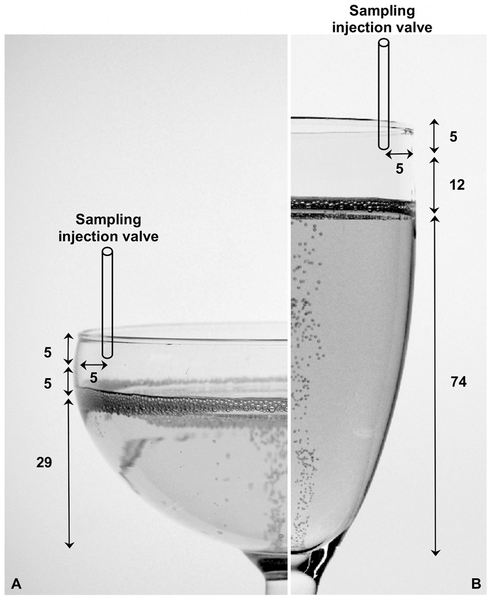A new study highlights the effects that champagne glass shape and temperature can have on carbonation upon serving - and therefore the drinking experience. The researchers, led by Gerard Liger-Belair (GSMA), Guillaume Polidori (GRESPI) and Clara Cilindre (URVVC) of the University of Reims in France, studied the gaseous CO2 and volatile organic compounds like ethanol in the space above the champagne surface after it is poured into either a tall, narrow flute or a wide, shallow coupe. The progressive CO2 and volatile organic compounds (VOC) losses escape in the form of bubbles (effervescence) and by “invisible” diffusion through the free surface of the glass. They found a much higher concentration of the gas above the flute than the coupe. Carbon dioxide is a potent irritant in the nasal cavity, as are many other organic compounds, which partly accounts for the very different drinking experiences from the two glasses.

Scheme illustrating the two well-defined valve sampling injection valve positions in the headspace above the champagne surface, whether champagne is served into the coupe (a) or into the flute (b) (dimensions are indicated in mm). doi:info:doi/10.1371/journal.pone.0030628.g001
These results were also visualized by micro-gas chromatography and infrared thermography, which provided images of the gas escaping from the champagne surface. The authors also determined that decreasing the champagne temperature decreased ethanol vapor concentrations in the headspace of a glass but had no impact on the level of gaseous CO2 found above the flute.
These results "might be a precious resource to depict champagne consumer's sensation according to various tasting conditions," says Cilindre.
Citation: Liger-Belair G, Bourget M, Pron H, Polidori G, Cilindre C (2012) Monitoring Gaseous CO2 and Ethanol above Champagne Glasses: Flute versus Coupe, and the Role of Temperature. PLoS ONE 7(2): e30628. doi:10.1371/journal.pone.0030628






Comments